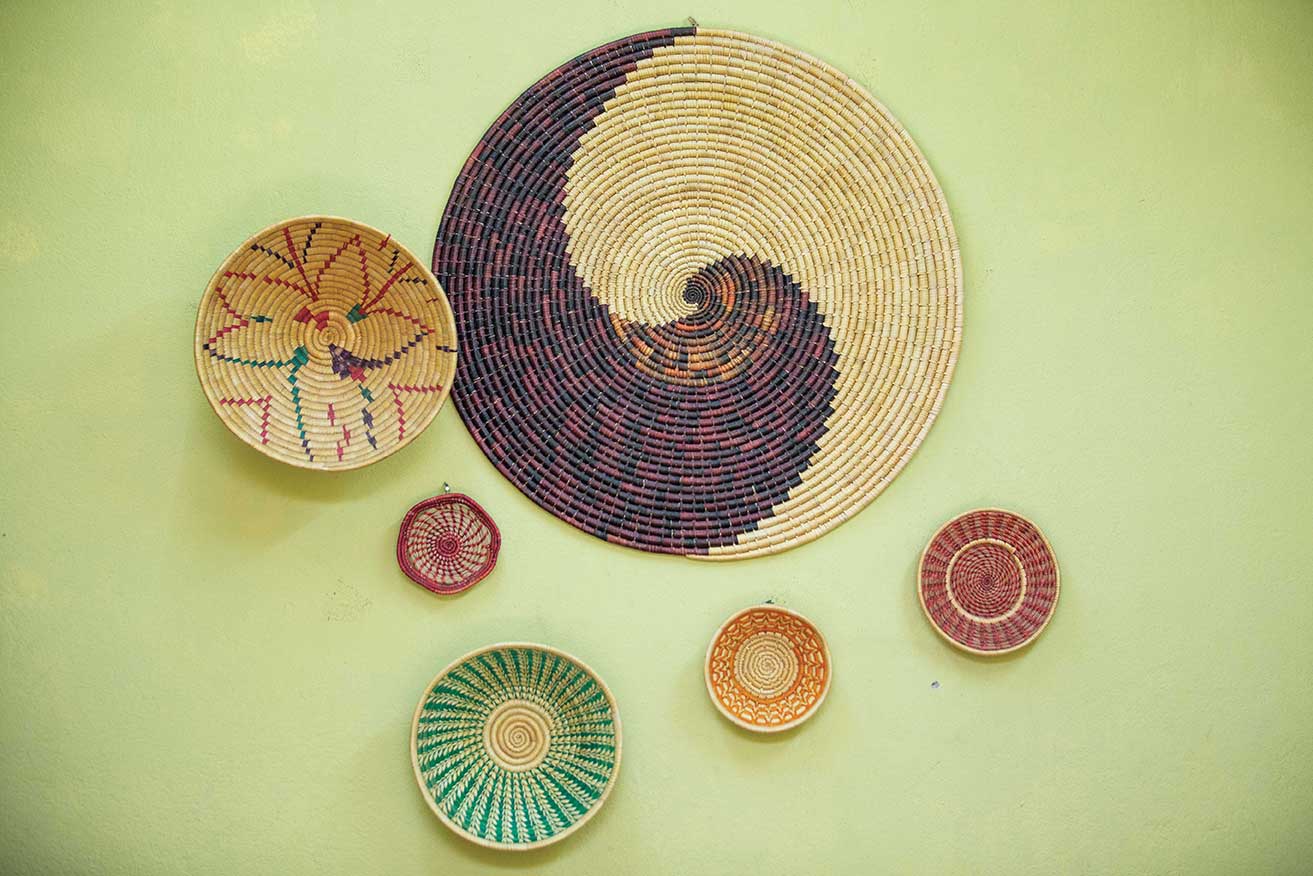
In the space of ten minutes during a recent school day, eight students generated a list of more than fifty crafts made in the vicinity of their school, Shree Mangal Dvip Boarding School (SMD). Located a short walk from Boudhanath, SMD provides sound education, boarding and health care for more than 500 students. It is centered on its mission to serve children from remote Himalayan villages by preserving a Buddhist way of life. The students themselves reflect a multiplicity of Tibetan-based cultures. Beyond SMD’s gate, Boudha is a mecca of Nepali culture of all kinds. Artisans—as an encapsulation of this tradition—create an array of objects, working with myriad tools, techniques, materials and processes. In fact, just outside SMD’s gate lie workshops where artisans mold, weld, blacksmith, shape and emboss metals into ritual vessels and weave carpets, textiles and baskets.
The living culture surrounding the school led to a pilot experiential learning course at SMD focusing on Nepali handcrafts within the particular context of Boudha. In an early stage of the project when the senior students (16-19 years) began to document the clusters of traditional workshops around Boudha, they sketched a poster-size map. So began their naming of the course “Cultural Mapping.”
Cultural Mapping was inspired by the world of traditional handcraft that enables a comprehensive platform for learning. In addition to cultural heritage, craft offers learning in the domains of indigenous knowledge; physical dexterity; sustainability practices; apprenticeship models; collaboration; technique and innovation; haptic or sensory experience; materials science; character education, such as respect, humility, diligence and resourcefulness; and finally, the value of silence as a condition for deep learning. This culture-based methodology recognizes craft as a fundamental enterprise of homo sapiens. Moreover, it educates based on humans embedded in both local and global ecosystems.
The early meetings of the seminar built a framework of ideas drawing from cultural anthropology, aesthetics and design. What is culture? What is craft, in its many iterations? How is artisanship relevant today? We considered concepts of cultural heritage; the pros, and cons, of cultural preservation; the social role of beauty; the shifting position of traditional artisans—from the most searing of physical labor to entrepreneurial possibilities and the world market of goods.

Next, we examined approaches to ethnographic interviewing. In the meantime, students spotted particular workshops along the roads they take in Boudha and selected a craft they wished to research. They generated their own central questions to drive their exploration. Some questions emanated from a twenty-first century mindset: students researching incense posed the question: why do Nepalis burn incense and is it healthy for humans and the environment? Other students delved into more traditional inquiry: what is the origin of singing bowls? Still others wondered about process: how is lokta paper made and how difficult are thangka to paint? On furniture making, how do specific designs reveal culture? And pottery: why do people use plastic over clay today and can we sustain more traditional ways?
The use of their neighborhood as an experiential classroom shaped the course. When the first phase of students expressed their motivations for committing to the no-credit, mandatory-attendance class, a typical response was “We don’t experience daily life in textbooks; we have many beliefs in our culture to explore” or “We don’t know the history and culture of our own villages to know what to preserve.”
It is the experiential element that is the crux of the learning. Allow the makers—the local experts—and their works to talk back. Listen by observing. Notice how tools and materials have their own power to react to human intervention. Learn by awakening the senses: consider the rhythmic but variable sounds of a hammer tapping on metal, a knife carving through wood, the dunking and swishing of lokta fibers suffusing a paper mould in water. At Tibetan Handicraft and Paper in Kopan, our hands also became sensitized to the slippery feel of soaking lokta fibers, and how once dried, they transform into crisp, sturdy sheets of paper. Around the corner from SMD, we observed looms twice as tall as us in front of which women and men were weaving carpets so rapidly their hands were a blur. We likened their “translation” of the paper carpet patterns hanging at eye level into wool carpets on the loom to a musician interpreting music notes on an instrument.
Other experiences included climbing up the hill from SMD to visit Himalayan Hope Home for girls, where there’s a workshop of the NGO Weaving for Empowerment. Founder Sonam Doka Sherpa introduced us to the dhaka weavers there. After Solukhumbu women sustained the ruin of their households during the 2015 earthquake, Sonam mobilized their indigenous weaving skills for income by creating a workshop in the nurturing environment of the girls’ home. The weavers not only demonstrated the process behind one of Nepal’s prized crafts but also addressed the real-life challenges of working women serving simultaneously as the primary caretakers of their children. We learned further about market limitations such as the expense of imported thread.
We discovered that some objects ubiquitous in Boudha are produced elsewhere. So we headed to Swayambu to witness incense making at Thrangu Tara Abbey. Tibetan medical doctor Dr. Yangdon, the nun who also oversees incense production, explained the science behind the herbal recipe. While we became immersed in the rhythmic repetitions of rolling and trimming the sticks and inhaled the earthy scent of the ingredients, she conveyed how the process acts as a form of meditation. A day trip later took us to Guru Arts Enterprises in Lalitpur where we stepped into a series of workshops. Director Rajesh Chitrakar detailed how the artisans wield wax, moldings and molten recycled metal to create sacred statues. Thereafter, we visited the Pottery Training Center at Bolachha Tole in Bhaktapur to try our hands at the wheel, view the kiln and discover how the workshop is expanding the concept of the pottery craft by offering classes for stress reduction and relaxation.
We also appealed to “in-house experts” to expand our appreciation of craft. SMD’s Principal and Vice Principal joined the seminar to share their scholarly knowledge of mala prayer beads and thangka. They also elaborated on the common street snack, khapse, and its role in rituals. Nearby resident musician Sujendra Dohj Karki played selections on the basuri, or bamboo flute, accompanied by careful explanations of the instrument and its healing effects. In response to ways in which students might represent artisans and their crafts, artist Mesa Schumacher led an animated workshop on techniques for framing photographs and narrating a story through image

.
These experiences were buttressed by “design problems” or “culture sets” during school meetings. Informed by David Macaulay’s well-wrought satire of archaeological practices Motel of the Mysteries (1979), students dwelled, for example, on a pastel plastic toilet bowl cleaner placed in front of them. They were instructed to view it as a foreign relic unearthed by archaeologists and dated to a civilization 400 years ago. Their task was to determine what its function was and how it was made. At first, everyone suggested things familiar to their own culture: a type of gong, mortar for chilis, butter tea maker, a horse toothbrush (laughter). When coaxed out of their cultural orientation, they submitted it was a primitive toy, a floor cleaner, a prehistoric mixer, a sorcerer’s wand. Our contemporary outlook intervened again when student Gyaltsen Lama commented that the society long ago opted for a material called “plastic” that was now known not to decompose.
In other meditations on objects, we moved into physical and abstract dimensions of craft—from form to beauty, and the haptic attention to touch, smell, sound. The aim was to allow the objects, their materials and their anonymous makers to talk back. Take a yak bell: its form, texture, sheen and ring took students beyond their viewing it as a common object. A series of juju yoghurt bowls, Nepali and Indian disposable clay cups, terracotta ritual vessels and a highly refined clay teapot spawned other discussions. A study of the designs depicted on a collection of embroidered objects pieced together a particular narrative of Hindu and Buddhist cosmologies.
Feedback on Cultural Mapping has hinged on visits to the artisan workshops. Tsewang Diki Ghale noted, “I feel it was good knowing that the artisans were eager to share their experiences and their journey with us. I got a chance to talk with my neighbors, which we don't usually do even if we see them each day.” In this year’s seminar, Pema Dekyi Lama relates, “I am learning the stories behind local cultural tools and objects that we can see around us…it creates the awareness that we are living in a country rich in cultural and spiritual practices and I think that is fortunate for all of us.” “We choose the simplest of crafts,” SMD’s student librarian Yangchen Dolma Tamang remarked further, “and amazingly they turn out to be some part of culture. Moreover, we are able to understand the level of passion, hard work and skill that accompany an apparently simple creation. This has helped develop a profound respect for the creators.”
Students drive the direction our studies. This year some would like to take a wider view of “craft.” To that end, they visited the American Center for a close-up look at library science and are planning a field trip to Mahindra Electric to learn the artisanship behind electric cars. For those who expressed an interested in exploring craft beyond Nepal, the Japanese Embassy is hosting an exhibition of work by artist Okumura Toshimichi who incorporates several traditional Japanese materials and techniques.
Future activities include a visit to the Living Traditions Museum in Bhaktapur and student reviews of Judith Conant Chase’s related book The Beauty of Purposeful Living: Living Traditions of Nepal (2019). A sustainable social development program jointly run by Tribhuvan University and Norwegian University of Science and Technology will bring us additional perspective on the role of craft through their development of a folk museum in Upper Mustang’s Kagbeni.
Ultimately, the goal is to turn consciousness of traditional practices over to Nepali youth. Again, in Tsewang’s words, “If Nepali teenagers find interest in cultural things by visiting workshops of artisans, then that will be beneficial for our country as they might create the possible opportunity to expand our culture and tradition around the world. I believe that if you give tools to students, they can transform into opportunities for our society.” Yangchen concludes, “Especially in today’s world where technology is preferred to do the smallest of work and youngsters are more attracted to western cultures, the need for embracing our own culture is necessary, otherwise we may lose our identity forever.”
Acknowledgements to Shree Mangal Dvip Boarding School’s Principal Wangchuk Tenzin Lama, Director Shirley Blair, student contributors and all artisans for their wholehearted support of the Cultural Mapping project. Additional appreciation to Tamera Bedford and Global Dental Relief for first introducing me to this extraordinary school.
The Cultural Mapping pilot project continues to evolve as an intercultural education program. If you would like to offer any feedback, would like to join in the growth of the program, have an interest in contributing or presenting your craft or would like students to visit your workshop or other craft site, please contact Claire Cuccio: cscuccio@alumni.stanford.edu











